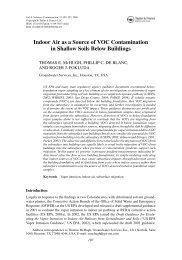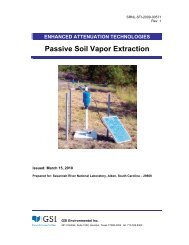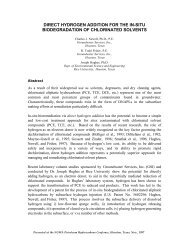Calculation and Use of First-Order Rate Constants for Monitored ...
Calculation and Use of First-Order Rate Constants for Monitored ...
Calculation and Use of First-Order Rate Constants for Monitored ...
Create successful ePaper yourself
Turn your PDF publications into a flip-book with our unique Google optimized e-Paper software.
plots serve to characterize the distribution <strong>of</strong> contaminantmass within space at a given point in time. A single C vs. Dplot provides no in<strong>for</strong>mation with regard to the variation <strong>of</strong>dissolved contaminant mass over time <strong>and</strong>, there<strong>for</strong>e, cannotbe employed to estimate the time required <strong>for</strong> the dissolvedplume concentrations to be reduced to a specified remediationgoal. This rate constant incorporates all attenuationparameters (sorption, dispersion, biodegradation) <strong>for</strong>dissolved constituents after they leave the source. <strong>Use</strong> <strong>of</strong> therate constant derived from a C vs. D plot (i.e., characterization<strong>of</strong> contaminant mass over space) <strong>for</strong> this purpose (i.e., tocharacterize contaminant mass over time) will provideerroneous results. The C vs. D-based rate constant indicateshow quickly dissolved contaminants are attenuated oncethey leave the source but provides no in<strong>for</strong>mation on howquickly a residual source zone is being attenuated. Note thatmost sites with organic contamination will have some type <strong>of</strong>continuing residual source zone, even after active remediation(Wiedemeier et al., 1999), making the C vs. D rate constantinappropriate <strong>for</strong> estimating plume lifetimes <strong>for</strong> most sites.Biodegradation <strong>Rate</strong> Constant: Another type <strong>of</strong> error occursif a C vs. D rate constant is used as the biodegradation rateterm ( λ ) in a solute transport model. The attenuation rateconstant derived from the C vs. D plot already reflects thecombined effects <strong>of</strong> contaminant sorption, dispersion, <strong>and</strong>biodegradation. Consequently, use <strong>of</strong> a C vs. D rate constantas the biodegradation rate within a model that separatelyaccounts <strong>for</strong> sorption <strong>and</strong> dispersion effects will significantlyoverestimate attenuation effects during ground-water flow.These examples serve to illustrate the need to ensure anappropriate match between the significance <strong>and</strong> use <strong>of</strong> each rateconstant. Further guidelines regarding derivation <strong>and</strong> use <strong>of</strong>attenuation rate constants are provided below.Key Point:There are three general types <strong>of</strong> first-order rate constants thatare commonly used <strong>for</strong> MNA studies: (1) Concentration vs.Time,(2) Concentration vs. Distance, <strong>and</strong> (3) Biodegradation.<strong>Rate</strong> <strong>Constants</strong> vs. Half-LivesBoth first-order rate constants <strong>and</strong> attenuation half-lives representthe same process, first-order decay. Some environmentalpr<strong>of</strong>essionals prefer to use rate constants (in units <strong>of</strong> per time) todescribe the first-order decay process, while others preferhalf-lives. These two terms are linearly related by:<strong>Rate</strong> constant = 0.693 / [ half-life ] <strong>and</strong>Half-life = 0.693 / [ rate constant ]For example, a 2 year half-life is equivalent to a first-order rateconstant <strong>of</strong> 0.35 per year. This document describes the firstorderdecay process in terms <strong>of</strong> rate constants instead <strong>of</strong> halflives.Key Point:<strong>Rate</strong> constants <strong>and</strong> half-lives represent the same first-order decayprocess, <strong>and</strong> are inversely related.Appropriate <strong>Use</strong> <strong>of</strong> Attenuation <strong>Rate</strong> <strong>Constants</strong> inNatural Attenuation StudiesAttenuation rate constants may be used <strong>for</strong> the following threepurposes in natural attenuation studies:Plume Attenuation: Demonstrate that contaminants arebeing attenuated within the ground-water flow system;Plume Trends: Determine if the affected ground-water plumeis exp<strong>and</strong>ing, showing relatively little change, or shrinking;<strong>and</strong>Plume Duration: Estimate the time required to reach groundwaterremediation goals by natural attenuation alone.Appropriate use <strong>of</strong> the various attenuation rate constants <strong>for</strong>evaluation <strong>of</strong> plume attenuation, trends, <strong>and</strong> duration is shown inTable 1.As described in the U.S. EPA MNA Directive (U.S. EPA, 1999):Site characterization (<strong>and</strong> monitoring) data are typicallyused <strong>for</strong> estimating attenuation rates. These calculatedrates may be expressed with respect to either time ordistance from the source.Time-based estimates are usedto predict the time required <strong>for</strong> MNA to achieve remediationobjectives <strong>and</strong> distance-based estimates provide anevaluation <strong>of</strong> whether a plume will exp<strong>and</strong>, remain stable,or shrink.To clarify the applicability <strong>of</strong> the various first-order decay rateconstants, appropriate nomenclature is useful to indicate thesignificance <strong>of</strong> each term. For example, point decay rates (definedTable 1.Summary <strong>of</strong> <strong>First</strong>-<strong>Order</strong> <strong>Rate</strong> <strong>Constants</strong> <strong>for</strong> Natural Attenuation Studies<strong>Rate</strong> Constant Method <strong>of</strong> Analysis SignificancePoint Attenuation<strong>Rate</strong> (Fig. 1)(k point , time per year)Bulk Attenuation <strong>Rate</strong>(Fig. 2)(k; time per year)Biodegradation <strong>Rate</strong>(Fig. 3)(λ, time per year)C vs. T PlotC vs. D PlotModel Calibration,Tracer Studies,<strong>Calculation</strong>sReduction in contaminantconcentration over time at asingle pointReduction in dissolvedcontaminant concentration withdistance from sourceBiodegradation rate <strong>for</strong>dissolved contaminants afterleaving source, exclusive <strong>of</strong>advection, dispersion, etc.PlumeAttenuation<strong>Use</strong> <strong>of</strong> <strong>Rate</strong> ConstantPlumeTrends?PlumeDuration?NO* NO* YESYES NO* NOYES NO NO* Note: Although assessment <strong>of</strong> an attenuation rate constant at a single location does not yield plume attenuation in<strong>for</strong>mation, or plumetrend in<strong>for</strong>mation, an assessment <strong>of</strong> general trends <strong>of</strong> multiple wells over the entire plume is useful to assess overall plume attenuation<strong>and</strong> plume trends.3






